Submitted:
22 April 2024
Posted:
25 April 2024
You are already at the latest version
Abstract
Keywords:
1. Introduction
2. Study Area
- 1)
- >1) The dry season (November to April-May) is marked by the prevalence of maritime trade winds towards the west and continental trade winds inland.
- 2)
- >2) The rainy season (May-June to October) is dominated by the monsoon flow from the St. Helena anticyclone.
3. Materials and Methods
3.1. Data
3.2. Mapping the Spatial and Temporal Distribution of Flooded Areas
3.3. Comparison of Existing 100-Years Flood Prone Areas with Flooded Areas Mapping Using Sentinel-1, GSW Layers and Digital Elevation Model
3.4. Estimation of Flood Exposure
3.4.1. Exposed People
3.4.2. Affected Cropland and Urban
4. Results
4.1. Mapping of flooded Areas Using Sentinel-1, GSW Layers and Digital Elevation Model
4.2. Comparison Flooded Areas Obtained by Remote Sensing (Google Earth Engine) with 100-year Flood Prone Areas Obtained Using Hydrological And Hydraulic Modelling
4.3. Exposed Population Assessment
4.3. Exposed Urband and Cropland
5. Discussion
6. Conclusions
Supplementary Materials
Author Contributions
Data Availability Statement
Acknowledgments
Conflicts of Interest
References
- Ndehedehe, C. Hydro-Climatic Extremes: Climate change and human influence. In Hydro-Climatic Extremes in the Anthropocene; Springer International Publishing, 2023; pp 25–55. [CrossRef]
- UNISDR-CRED. The Human cost of weather-related disasters 1995–2015–, The United Nations office for Disaster Risk Reduction (UNISDR) and Centre for Research on the Epidemiology of Disasters (CRED), 1- 30, 2015.
- EM-DAT. The OFDA/CRED International Disaster Database, at: https://public.emdat.be/data, last access: 24 January 2024.
- Chen, Y.; Zhou, H.; Zhang, H.; Du, G.; Zhou, J. Urban flood risk warning under rapid urbanization. Environ. Res. 2015, 139, 3–10. [Google Scholar] [CrossRef] [PubMed]
- Sy, B.; Frischknecht, C.; Dao, H.; Consuegra, D.; Giuliani, G. Reconstituting past flood events: the contribution of citizen science. Hydrol. Earth Syst. Sci. 2020, 24, 61–74. [Google Scholar] [CrossRef]
- de Moel, H.; Aerts, J. C.; Koomen, E. Development of flood exposure in the Netherlands during the 20th and 21st Century. Global. Environmental. Change 2011, 21, 620–627. [Google Scholar] [CrossRef]
- Rahman, M.; Ningsheng, C.; Mahmud, G. I.; Islam, M. M.; Pourghasemi, H. R.; Ahmad, H.; Habumugisha, J. M.; Washakh, R. M. A.; Alam, M.; Liu, E. Flooding and its relationship with land cover change, population growth, and road density. Geoscience Frontiers. 2021, 12, 101224. [Google Scholar] [CrossRef]
- Hirabayashi, Y.; Mahendran, R.; Koirala, S.; Konoshima, L.; Yamazaki, D.; Watanabe, S.; Kim, H.; Kanae, S. Global Flood Risk under Climate Change. Nature. Climate. Change 2013, 3, 816–821. [Google Scholar] [CrossRef]
- Kedowide, C.M.G ; Cissé, O. Adaptating to flooding impact in Yeumbeul Nord, a suburb of Dakar, Senegal: Generation of knowledge and of Mapping Data at the crossroads of a need for the territorialization of spatialized phenomena, in proceedings of the resilient cities, Bonn, Germany, 29-31 May. 2014. 1-20, available at http://hdl.handle.net/10625/53299, last access 08 March 2024.
- Waca. Floods in Senegal, are retention basins part of the Solution? at: https://www.wacaprogram.org/article/floods-senegal-are-retention-basins-part-solution, last access: 8 March 2023.
- Li, C.; Dash, J.; Asamoah, M.; Sheffield, J.; Dzodzomenyo, M.; Gebrechorkos, S. H.; Anghileri, D.; Wright, J. Increased flooded area and exposure in the white Volta river basin in Western Africa, identified from multi-Source remote sensing data. Scientific. Reports. 2022, 12, 3701. [Google Scholar] [CrossRef] [PubMed]
- Sy, B. Approche multidisciplinaire de l’évaluation de l’aléa d’inondation à Yeumbeul Nord, Dakar, Sénégal: La contribution de La science citoyenne, thèse Université de Genève.2019. [CrossRef]
- Muis, S.; Güneralp, B.; Jongman, B.; Aerts, J. C.; Ward, P. J. Flood Risk and Adaptation Strategies under Climate Change and Urban Expansion: A Probabilistic Analysis Using Global Data. Science of the Total Environment. 2015, 538, 445–457. [Google Scholar] [CrossRef] [PubMed]
- DeVries, B.; Huang, C.; Armston, J.; Huang, W.; Jones, J. W.; Lang, M. W. Rapid and robust monitoring of flood events using Sentinel-1 and Landsat data on the Google Earth Engine. Remote Sensing of Environment. 2020, 240, 111664. [Google Scholar] [CrossRef]
- Ward, D. P.; Petty, A.; Setterfield, S. A.; Douglas, M. M.; Ferdinands, K.; Hamilton, S. K.; Phinn, S. Floodplain inundation and vegetation dynamics in the Alligator rivers region (Kakadu) of Northern Australia assessed uing optical and radar remote sensing. Remote Sensing of Environment. 2014, 147, 43–55. [Google Scholar] [CrossRef]
- Singha, M.; Dong, J.; Sarmah, S.; You, N.; Zhou, Y.; Zhang, G.; Doughty, R.; Xiao, X. Identifying floods and flood-affected paddy rice fields in Bangladesh based on Sentinel-1 imagery and Google Earth Engine. ISPRS J. Photogrammetry and Remote Sensing. 2020, 166, 278–293. [Google Scholar] [CrossRef]
- Gorelick, N.; Hancher, M.; Dixon, M.; Ilyushchenko, S.; Thau, D.; Moore, R. Google Earth Engine: planetary-scale geospatial analysis for everyone. Remote sensing of Environment. 2017, 202, 18–27. [Google Scholar] [CrossRef]
- Tiwari, V.; Kumar, V.; Matin, M. A.; Thapa, A.; Ellenburg, W. L.; Gupta, N.; Thapa, S. Flood inundation mapping-Kerala 2018; Harnessing the Power of SAR, Automatic threshold detection method and Google Earth Engine. PLoS One 2020, 15, e0237324. [Google Scholar] [CrossRef] [PubMed]
- Moharrami, M.; Javanbakht, M.; Attarchi, S. Automatic Flood Detection Using Sentinel-1 Images on the Google Earth Engine. Environmental monitoring and assessment. 2021, 193, 1–17. [Google Scholar] [CrossRef] [PubMed]
- Johary, R.; Révillion, C.; Catry, T.; Alexandre, C.; Mouquet, P.; Rakotoniaina, S.; Pennober, G.; Rakotondraompiana, S. Detection of large-scale floods using Google Earth Engine and Google Colab. Remote Sensing. 2023, 15, 5368. [Google Scholar] [CrossRef]
- Ghouri, A. Y.; Khan, A.; Raoof, H.; Miandad, M.; Rehman, G. Flood mapping using the Sentinel-1 SAR dataset and application of the change detection approach technique (CDAT) to the Google Earth Engine in Sindh Province, Pakistan. Ecological Questions. 2024, 35, 1–18. [Google Scholar] [CrossRef]
- Rentschler, J.; Salhab, M.; Jafino, B. A. Flood exposure and poverty in 188 countries. Nature Communication. 2022, 13, 3527. [Google Scholar] [CrossRef] [PubMed]
- Van Den Homberg, M.; Susha, I. Characterizing data ecosystems to support official statistics with open mapping data for reporting on sustainable development Goals. ISPRS International Journal of Geo-Information. 2018, 7, 456. [Google Scholar] [CrossRef]
- Wouters, L.; Couasnon, A.; De Ruiter, M. C.; Van Den Homberg, M. J.; Teklesadik, A.; De Moel, H. Improving flood damage assessments in data-scarce areas by retrieval of building characteristics through UAV image segmentation and machine learning–a case study of the 2019 floods in Southern Malawi. Natural Hazards and Earth System Sciences. 2021, 21, 3199–3218. [Google Scholar] [CrossRef]
- Cea, L.; Álvarez, M.; Puertas, J. Estimation of flood-exposed population in data-scarce regions combining satellite imagery and high resolution hydrological-hydraulic modelling: a case study in the Licungo Basin (Mozambique). Journal of Hydrology: Regional Studies. 2022, 44, 101247. [Google Scholar] [CrossRef]
- Mbow, C.; Diop, A.; Diaw, A.; Niang, C. I. Urban sprawl development and flooding at Yeumbeul suburb (Dakar-Senegal). African Journal of Environmental Science and Technology. 2008, 2, 075–088. [Google Scholar]
- Sy, B.; Frischknecht, C.; Dao, H.; Giuliani, G.; Consuegra, D.; Wade, S.; Kêdowidé, C. Participatory approach for flood risk assessment: the case of Yeumbeul Nord (YN), Dakar, Senegal. WIT Transactions on the Built Environment. 2016, 165, 331–342. [Google Scholar] [CrossRef]
- PGIIS: Cartographie du risque d’inondation à l’échelle nationale; Projet de Gestions Intégrée des Inondations au Sénégal (PGIIS). 2022; 1–126.
- WHO: State of the Climate in Africa 2022. Word Meteorological Organization. 2022; 1330; 2023; 1-30, at https://www.google.com/url?sa=t&rct=j&q=&esrc=s&source=web&cd=&ved=2ahUKEwjJsIaPieWEAxU89LsIHZ3eBdAQFnoECA4QAQ&url=https%3A%2F%2Flibrary.wmo.int%2Fviewer%2F67761%2Fdownload%3Ffile%3D1330_State-of-the-Climate-in-Africa-2022_en.pdf%26type%3Dpdf%26navigator%3D1&usg=AOvVaw1N9WC_I_8xrPc-x4fs7z2i&opi=89978449, last access 08 March 2024.
- UNICEF: Responds to the Immediate Needs of Flood-Affected Children and Families in Senegal, at https://www.unicef.org/senegal/en/stories/unicef-responds-immediate-needs-flood-affected-children-and-families-senegal, last access 08 March 2024.
- OCHA: West and Central Africa: Flooding Situation - As of 16 August 2022., at https://reliefweb.int/report/congo/west-and-central-africa-flooding-situation-16-august-2022, last access 08 March 2024.
- ANAT: Atlas Cartographique. ANAT: Atlas Cartographique; Agence Nationale de l’Aménagement du Territoire: Dakar, 2020; pp. 1–69. [Google Scholar]
- ANSD: 5ème Recencement Général de La Population et de l’habitat; Agence Nationale de la Statistique et de la Démographie, 2023; 1–21.
- ANSD: Situation Économique et Sociale régionale; Agence Nationale de la Statistique et de la Démographie, 2013; 1-129.
- Torres, R.; Snoeij, P.; Geudtner, D.; Bibby, D.; Davidson, M.; Attema, E.; Potin, P.; Rommen, B.; Floury, N.; Brown, M. GMES Sentinel-1 Mission. Remote sensing of environment. 2012, 120, 9–24. [Google Scholar] [CrossRef]
- Malenovský, Z.; Rott, H.; Cihlar, J.; Schaepman, M. E.; García-Santos, G.; Fernandes, R.; Berger, M. Sentinels for Science: Potential of Sentinel-1,-2, and-3 missions for scientific observations of ocean, cryosphere, and land. Remote Sensing of environment. 2012, 120, 91–101. Malenovský, Z., Rott, H., Cihlar, J., Schaepman, M. E., García-Santos, G., Fernandes, R., & Berger, M. (2012). Sentinels for science: Potential of Sentinel-1,-2, and-3 missions for scientific observations of ocean, cryosphere, and land. Remote Sensing of environment, 120, 91-101. [CrossRef]
- Twele, A.; Cao, W.; Plank, S.; Martinis, S. Sentinel-1-Based Flood Mapping: A fully automated processing Chain. International Journal of Remote Sensing. 2016, 37 (13), 2990–3004. Twele, A., Cao, W., Plank, S., & Martinis, S. (2016). Sentinel-1-based flood mapping: a fully automated processing chain. International Journal of Remote Sensing, 37(13), 2990-3004. [CrossRef]
- Clement, M. A.; Kilsby, C.; Moore, P. Multi-temporal synthetic aperture radar flood mapping using change detection. Journal of Flood Risk Management. 2018, 11, 152–168. [Google Scholar] [CrossRef]
- ESA. Revisit and coverage frequency of the Sentinel-1 constellation, showing which areas are mainly covered with descending or ascending imagery, at Https://Sentinel.Esa.Int/Web/Sentinel/Copernicus/Sentinel-1/Acquisition-Plans, last access: 24 January 2024.
- Cian, F.; Marconcini, M.; Ceccato, P. Normalized Difference Flood Index for Rapid Flood Mapping: Taking Advantage of EO Big Data. Remote Sensing of Environment. 2018, 209, 712–730. [Google Scholar] [CrossRef]
- European Commission Global Human Settlement Layer - Open and free data and tools for assessing the human presence on the planet, available at: https://human-settlement.emergency.copernicus.eu/p2023Release.php, last access 22 April 2024.
- Tellman, B.; Sullivan, J. A.; Kuhn, C.; Kettner, A. J.; Doyle, C. S.; Brakenridge, G. R.; Erickson, T. A.; Slayback, D. A. Satellite imaging reveals increased proportion of population exposed to floods. Nature. 2021, 596, 80–86. [Google Scholar] [CrossRef] [PubMed]
- Kar, B.; Schumann, G. Reproducibility and replicability of flood models. Hydrological processes. 2022, 36(9), e14666. [Google Scholar] [CrossRef]
- Amitrano, D.; Di Martino, G.; Iodice, A.; Riccio, D.; Ruello, G. Unsupervised rapid flood mapping using Sentinel-1 GRD SAR images. IEEE Transactions on Geoscience and Remote Sensing. 2018, 56, 3290–3299. [Google Scholar] [CrossRef]
- Nghia, B. P. Q.; Pal, I.; Chollacoop, N.; Mukhopadhyay, A. Applying Google Earth Engine for flood mapping and monitoring in the downstream Provinces of Mekong River. Progress in Disaster Science. 2022, 14, 100235. [Google Scholar] [CrossRef]
- Giustarini, L.; Hostache, R.; Matgen, P.; Schumann, G. J.-P.; Bates, P. D.; Mason, D. C. A Change detection approach to flood mapping in urban areas using TerraSAR-X. IEEE Transactions on Geoscience and Remote Sensing. 2012, 51, 2417–2430, https://www.scopus.com/record/display.uri?eid=2-s2.0-84875707692&origin=inward&txGid=80f7a1beeeb5efc7c78e7e46e6626b75. [Google Scholar] [CrossRef]
- Smith, A.; Bates, P. D.; Wing, O.; Sampson, C.; Quinn, N.; Neal, J. New estimates of flood exposure in developing countries using high-resolution population data. Nature Communication. 2019, 10, 1814. [Google Scholar] [CrossRef] [PubMed]
- de Bruijn, J. A.; de Moel, H.; Jongman, B.; de Ruiter, M. C.; Wagemaker, J.; Aerts, J. C. A global database of historic and real-time flood events based on social media. Scientific data 2019, 6, 311. [Google Scholar] [CrossRef] [PubMed]
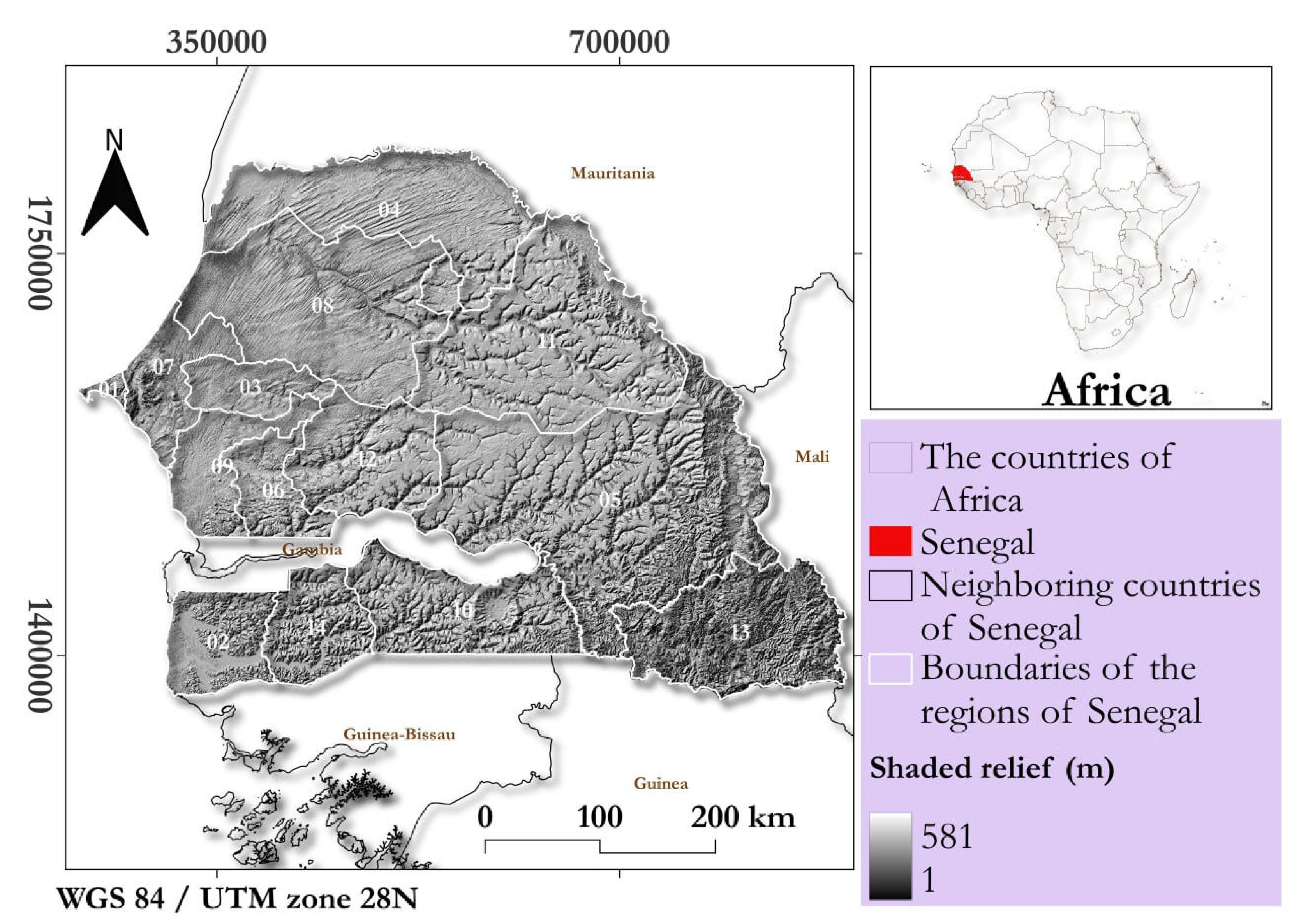
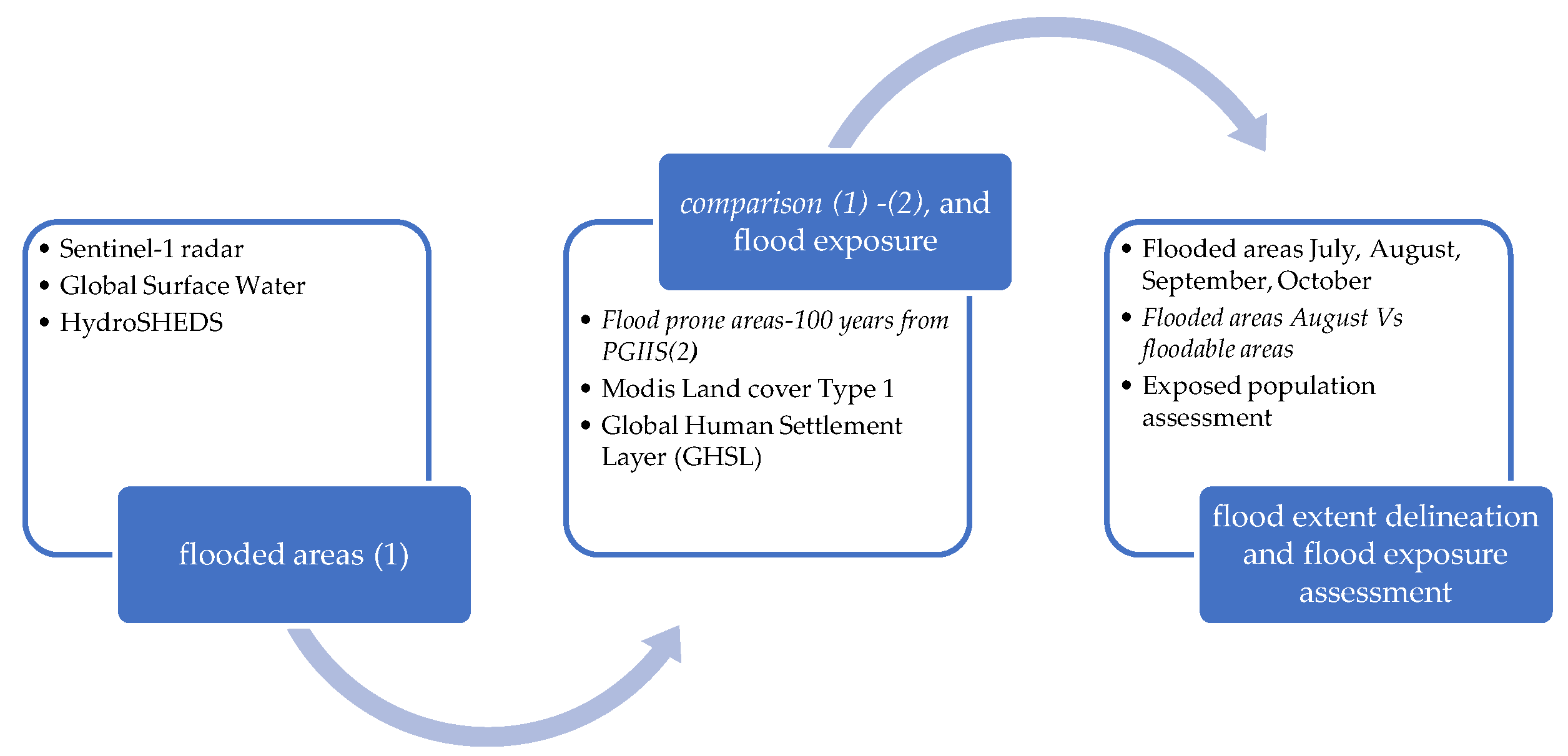
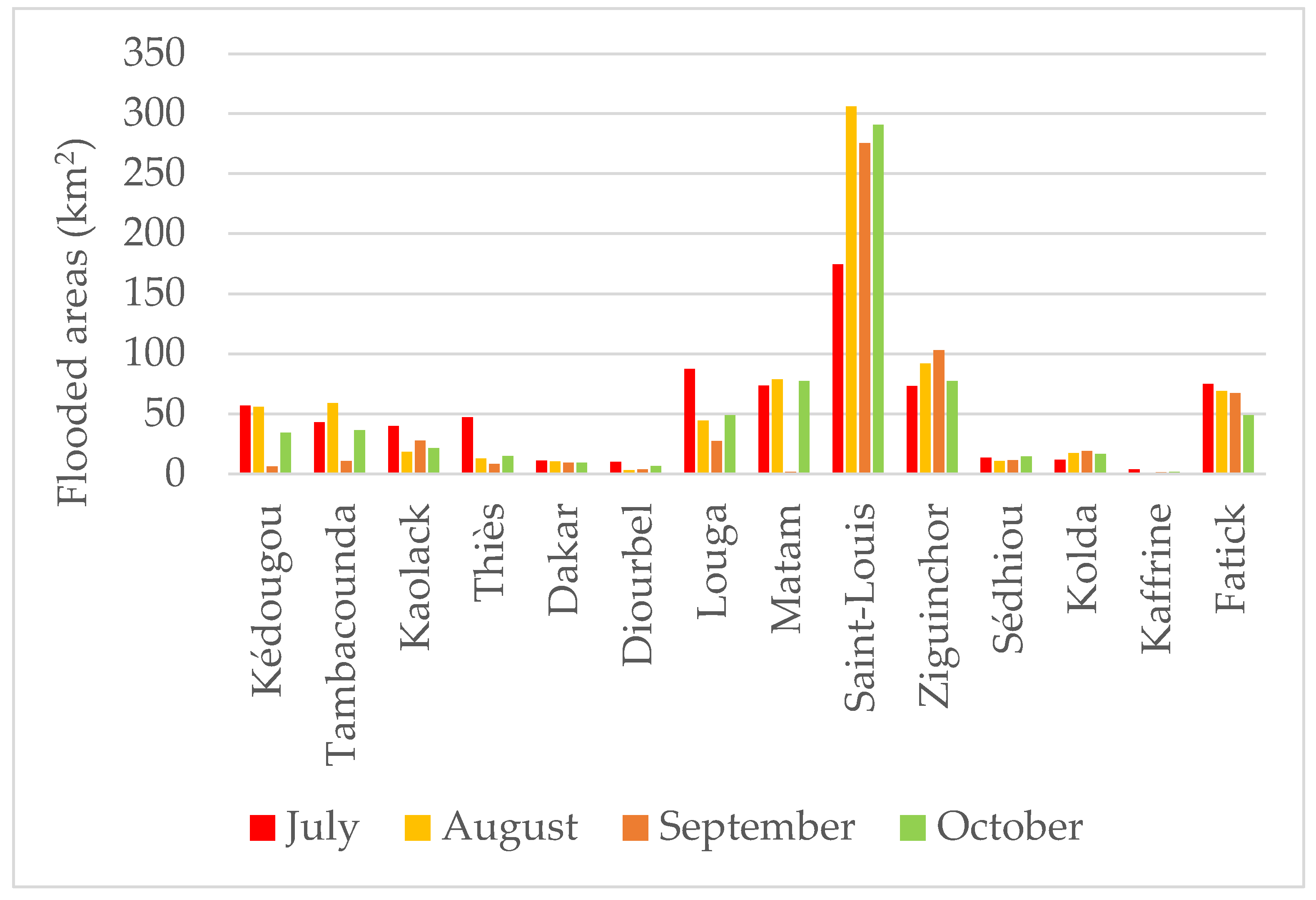
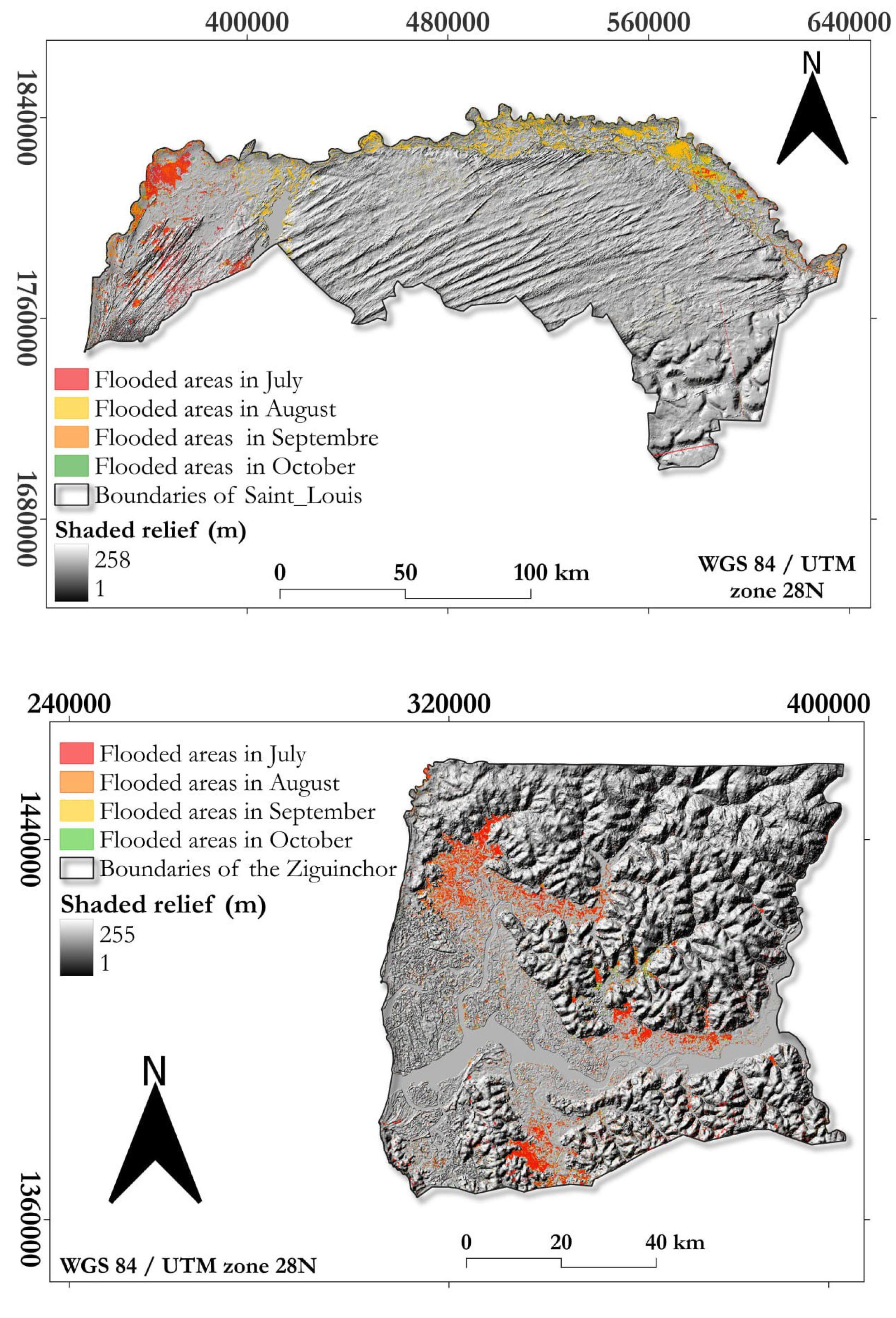
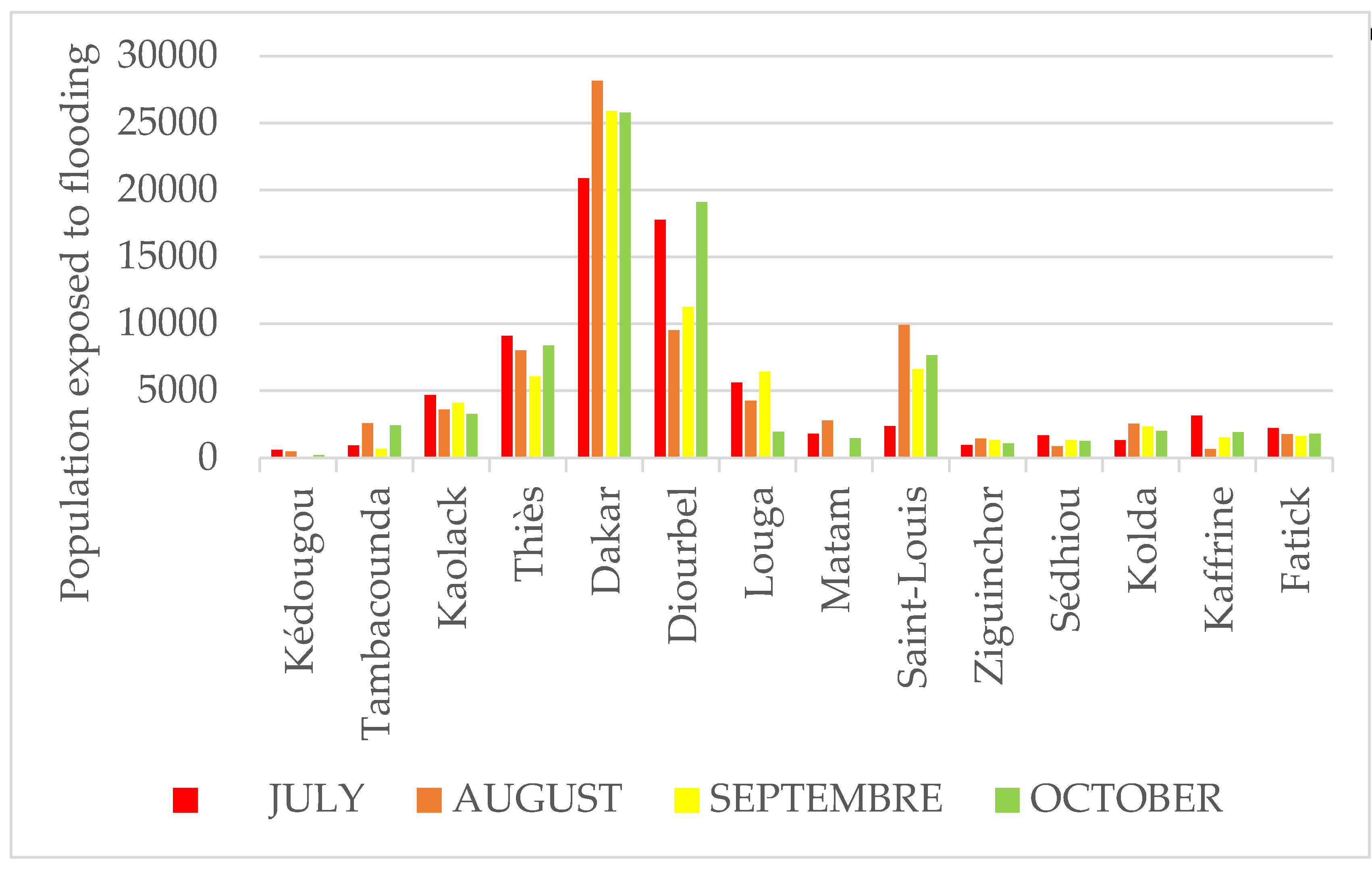
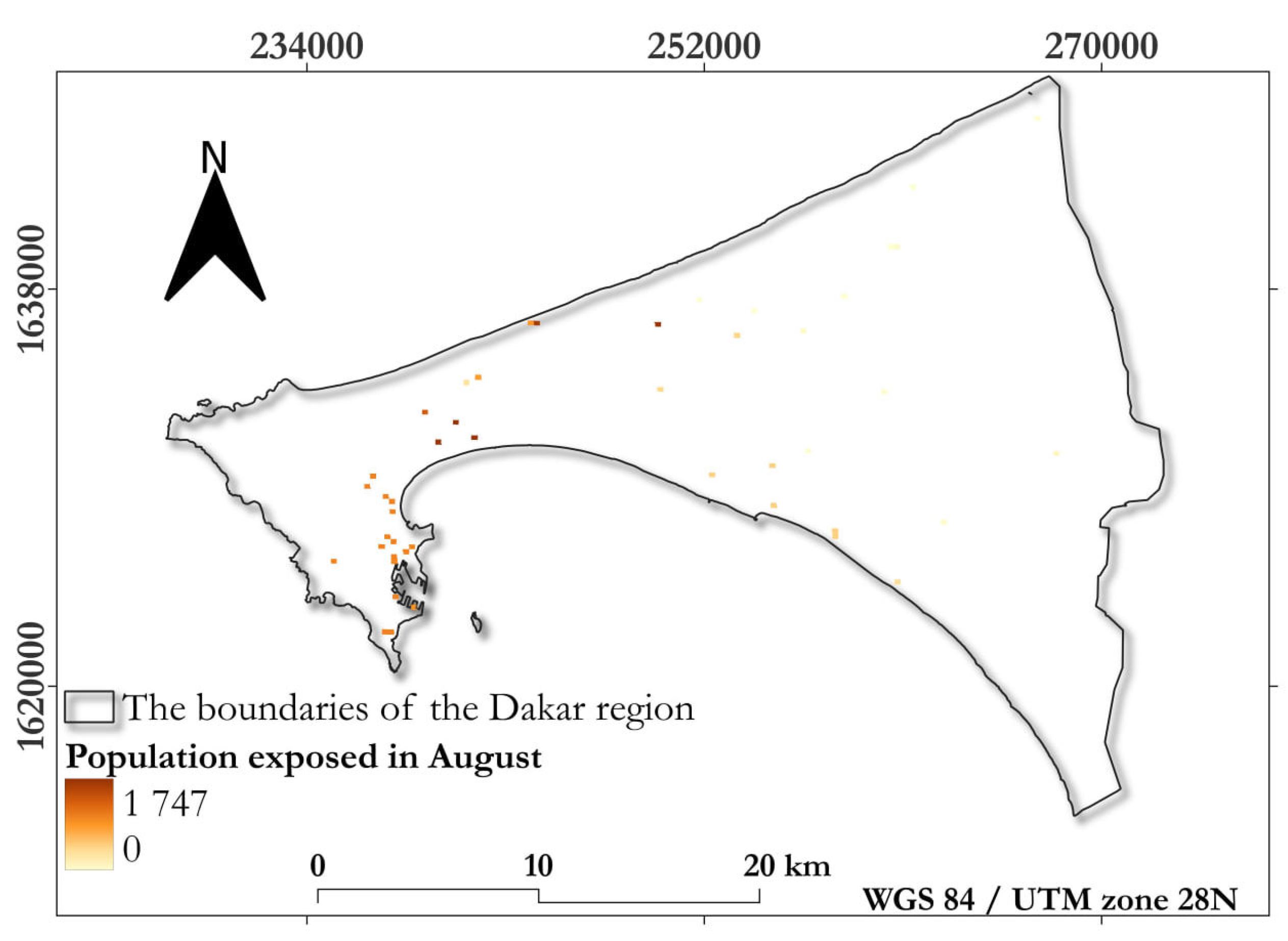
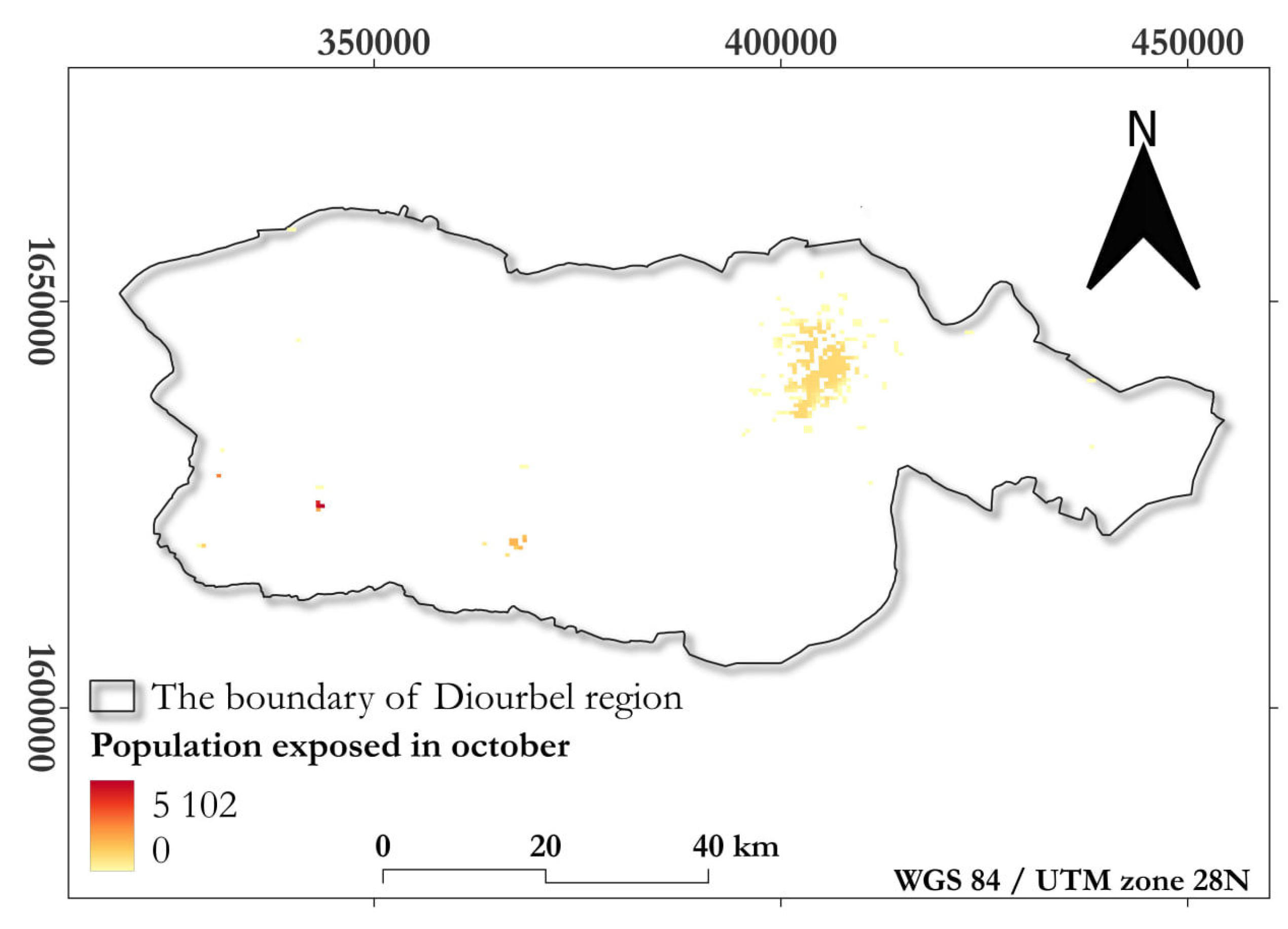
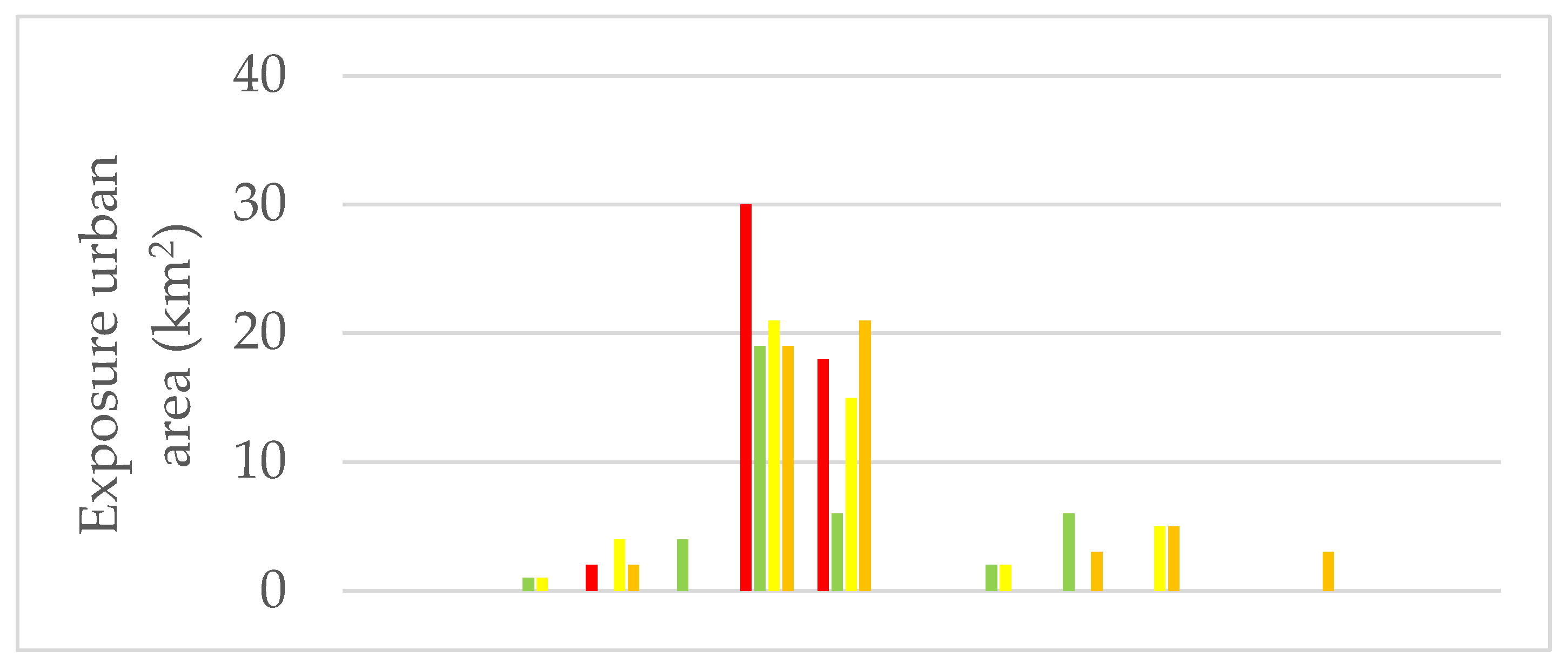
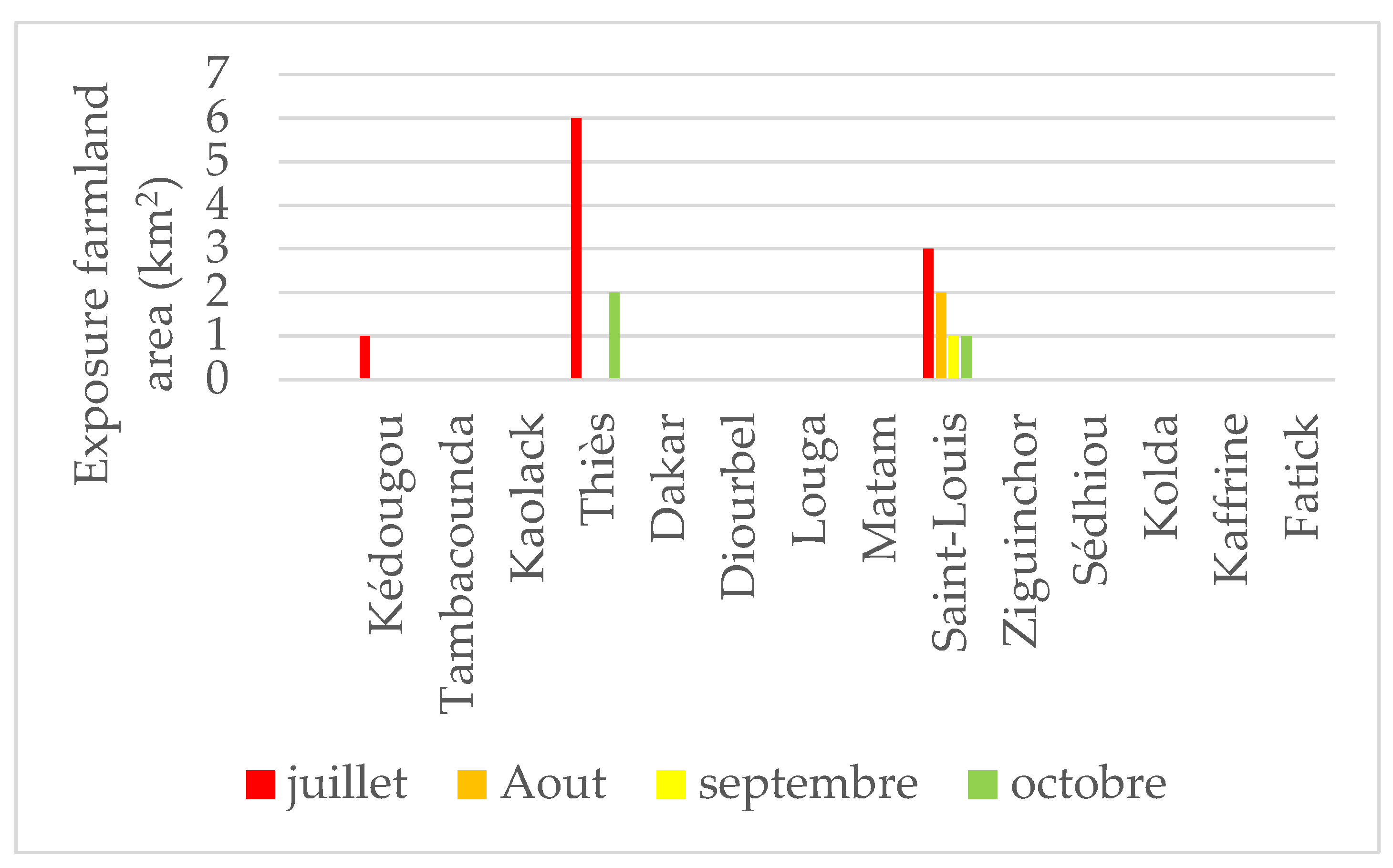
| Layers names | Sources | Date | Type | Resolution (m) |
|---|---|---|---|---|
| Administrative limits | LGA* | 2020 | Vector | |
| Sentinel-1 images | Copernicus | ** | Raster | 10 |
| *** | ||||
| Flood prone areas 100 Years | PGIIS | 2023 | Raster | |
| Global Surface Water | EC / JRC | 01-01-2022 | Raster | 30 |
| HydroSHEDS | WWF US | 22-02-2020 | Raster | 30 |
| Global Human Settlement Layer | EC / JRC | 31-12-2015 | Raster | 250 |
| MODIS Land Cover | NASA | 01-01-2020 | Raster | 500 |
| Region of Senegal | Flooded areas August from remote sensing (km2) | Flood prone areas PGIIS (km2) |
Overlap percentage |
|---|---|---|---|
| Dakar | 10.34 | 101.42 | 10.19 |
| Zinguinchor | 91.91 | 2992.43 | 3.07 |
| Diourbel | 2.99 | 1 093.56 | 0.27 |
| Saint-Louis | 309.2 | 9 666.56 | 3.20 |
| Tambacounda | 59.21 | 9 739.77 | 0.61 |
| Kaolack | 18.31 | 1 476.10 | 1.24 |
| Thies | 14.15 | 1 313.32 | 1.08 |
| Louga | 41.14 | 6 031.24 | 0.68 |
| Fatick | 69.1 | 3 059.26 | 2.26 |
| Kolda | 18.17 | 2 578.36 | 0.70 |
| Matam | 77.41 | 9 449.34 | 0.82 |
| Kaffrine | 1.04 | 2 631.82 | 0.04 |
| Kedougou | 56.22 | 2 740.52 | 2.05 |
| Sedhiou | 10.53 | 1 662.70 | 0.63 |
| Total | 779.54 | 54 536.34 | 1.43 |
Disclaimer/Publisher’s Note: The statements, opinions and data contained in all publications are solely those of the individual author(s) and contributor(s) and not of MDPI and/or the editor(s). MDPI and/or the editor(s) disclaim responsibility for any injury to people or property resulting from any ideas, methods, instructions or products referred to in the content. |
© 2024 by the authors. Licensee MDPI, Basel, Switzerland. This article is an open access article distributed under the terms and conditions of the Creative Commons Attribution (CC BY) license (http://creativecommons.org/licenses/by/4.0/).





